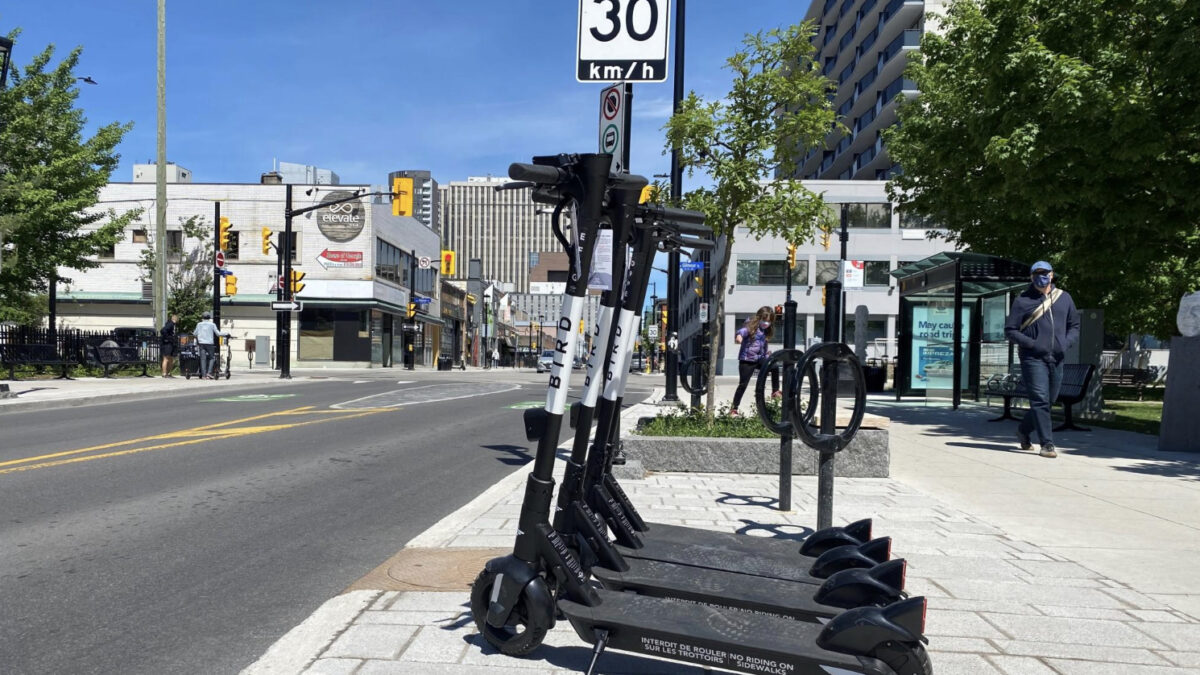An e-scooter pilot project begins May 15 in Ottawa, but advocates for the visually impaired say the city must ensure the companies renting them keep improving safety standards.
These critics also want police and bylaw officers to enforce strengthened rules for using and parking the devices.
Ontario launched a provincial electric scooter program in January 2020. This allowed municipalities to test, normalize and regulate scooter use within their jurisdictions.
The City of Ottawa has granted permission to two e-scooter companies — Bird Canada and Neuron Mobility — to operate within the urban area this spring and summer.
The way the scooters are parked after being used has been a key concern.
If scooters are improperly left on a sidewalk, a blind person could easily trip over them. The solution has been to increase the number of designated parking locations from five in 2021 to 13 in 2022. This year, 20 to 30 parking areas will be set aside.
Surveys of 1,400 residents revealed 83 per cent of respondents experienced misparked e-scooters in 2021. That number dropped to 40 per cent in 2022.
‘E-scooters are still a safety hazard for pedestrians, especially those with sight loss.’
— Kate Riccomini, program lead for advocacy and accessible community engagement, CNIB Foundation
Meanwhile, the average time to remove a misparked scooter has fallen from an hour to 15 minutes, according to Heidi Cousineau, program manager with the city’s transportation planning services department.
Although there have been improvements, some say there is still a lot of work to be done.
“It reduced the problem, it did not fix the problem,” said blindness advocate Kate Riccomini, program lead for advocacy and accessible community engagement with the CNIB Foundation (formerly known as the Canadian National Institute for the Blind).
Riccomini, who is partially blind, raised concerns about the management of e-scooter rentals at a committee meeting before city council’s approval of a continued pilot program for 2023.

She was responding to proposals from the e-scooter rental companies for better “geofencing” controls to regulate where the devices can be driven, as well the addition of audio signals to warn pedestrians of an approaching scooter.
“E-scooters are still a safety hazard for pedestrians, especially those with sight loss,” Riccomini told the committee. “Therefore, if you choose to continue the pilot into another year, it is imperative that not only do you maintain this technology, but that you continue to push for it to improve.”
The riding of e-scooters on sidewalks has been another major concern.
Forty-seven per cent of all respondents to the city surveys encountered sidewalk riding in 2022. That number was down significantly from 2021, when 79 per cent of respondents reported e-scooters being driven on a sidewalk.
However, the companies say this problem can be reduced through geofencing technology.
“What is happening in the e-scooter brain is that it is holding all the geofences in the computer. So, at any given time, it is able to react quickly to where it is moving. And so, that’s what prevents it from going onto a sidewalk or an undesirable area,” said Isaac Ransom, head of corporate affairs for Neuron Mobility Canada.
The data being held in the scooter’s on-board computer allows it to react nearly immediately, he said. This takes away previous delays and accuracy flaws associated with data transfer through the cloud and satellites.
Upgraded e-scooters come to a safe stop when it’s detected they’re riding in an unauthorized area.
‘There are limitations to what an e-scooter can do. It’s not a car, it’s not a speaker system, and so keeping that in mind, we need to work with the infrastructure that’s in the city and with the technology that’s in the e-scooters.’
— Ian Ransom, head of corporate affairs, Neuron Mobility Canada.
The problem of knowing where e-scooters are located led to the introduction of sound emission to serve as a warning to pedistrians. During the 2022 testing period, the devices emitted a constant noise when in motion to help pedestrians know when one was approaching. However, this adaptation presented problems, said Riccomini.
“The sounds chosen tended to get lost in even moderate traffic,” she said. “So if a couple cars are going by I could no longer hear the e-scooter, which defeated the purpose of having a sound in the first place.”
She wasn’t alone. Thirty-four per cent of survey respondents in 2022 did not hear the sound. And feedback was generally negative when it came to the noise. Many said it disturbed the enjoyment of the area, was distracting or people found it too quiet or, even, too loud.
“There are limitations to what an e-scooter can do. It’s not a car, it’s not a speaker system, and so keeping that in mind, we need to work with the infrastructure that’s in the city and with the technology that’s in the e-scooters,” said Ransom.
“We’ll always continue to try and find a solution that works, but we do think that it’s not just the sound that’s going to solve that problem. It’s geofencing, it’s understanding characteristics of the community that we’re riding in, it’s rider education, it’s ensuring that there’s compliance from those who are parking.”
Ransom also noted that their e-scooters offer voice guidance. That means if a rider experiences a problem, the e-scooter will provide a number to call. There are also instructions in braille on the top of the scooter and a QR code for contacting the company.




